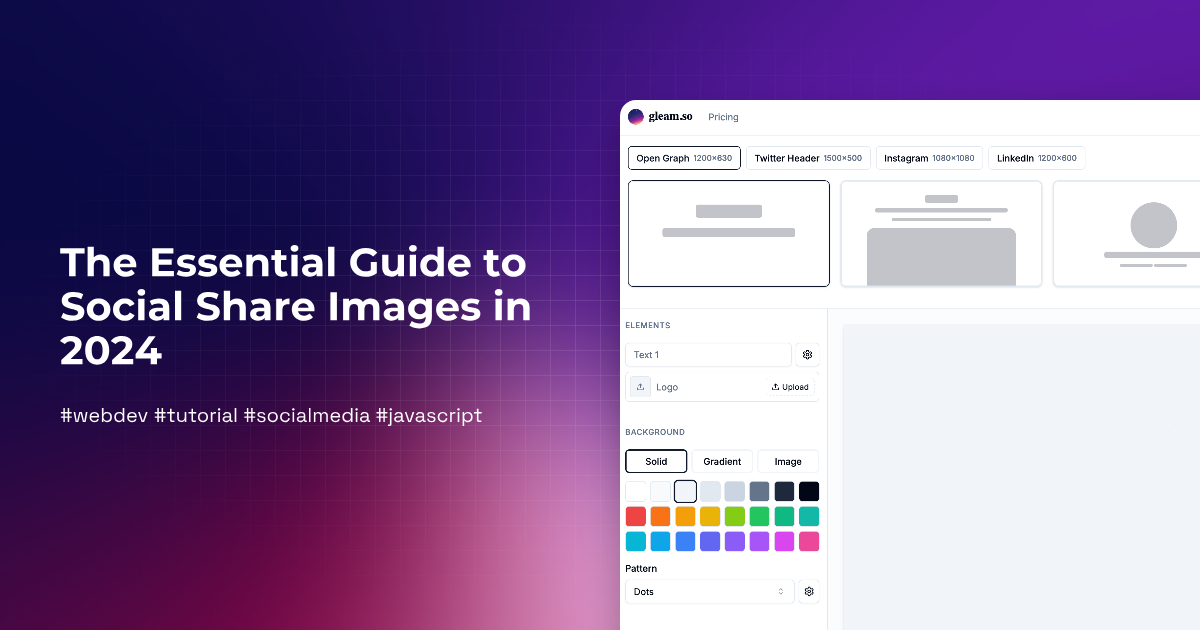The Essential Guide to Social Share Images in 2024
 anhphong
anhphong
As developers, we spend hours crafting great content, but often overlook how it appears when shared on social media. Let's fix that with this practical guide to social share images (OG images).
What Are OG Images & Why They Matter
Open Graph (OG) images are preview images that appear when your content is shared on social platforms. They're your first impression in a crowded social feed.
Simple example: When you share your blog post on Twitter/LinkedIn, the large image that appears is the OG image.
Quick Size Reference
Here's what you need to know for major platforms:
Facebook/LinkedIn:
- 1200 x 630px (1.91:1 ratio)
- Minimum: 600 x 315px
- Max file size: 8MB
Twitter:
- 1200 x 600px (2:1 ratio)
- Large card: 1200 x 600px
- Small card: 440 x 220px
Pro tip: Design for 1200 x 630px - it works well across all platforms.
Implementation in 30 Seconds
Add these meta tags to your <head>:
<!-- Basic OG Image -->
<meta property="og:image" content="https://yourdomain.com/og-image.png" />
<meta property="og:image:width" content="1200" />
<meta property="og:image:height" content="630" />
<!-- Twitter -->
<meta name="twitter:card" content="summary_large_image" />
<meta name="twitter:image" content="https://yourdomain.com/og-image.png" />
5 Design Tips That Actually Work
Text Hierarchy
Main message: 5-7 words max
Font size: Min 30px (test on mobile)
Contrast is King
Dark text on light bg (or vice versa)
Test: Can you read it at thumbnail size?
Brand Consistency
Logo placement (pick a corner and stick to it)
Use your brand colors
Whitespace
Don't overcrowd
Leave 10% padding on edges
Mobile-First
Test how it looks on phone screens
Most shares are viewed on mobile
Common Gotchas to Avoid
❌ Using generic stock photos ✅ Custom graphics or branded templates
❌ Text too small/too much ✅ Large, scannable text
❌ Inconsistent branding ✅ Use templates with your brand elements
Quick Testing
Test your OG images with these tools:
Automate It (Because We're Developers)
Why create OG images manually when you can automate? Some approaches:
DIY Solution:
// Using Node.js + Sharp
const sharp = require('sharp');
async function generateOG(text) {
return await sharp('template.png')
.resize(1200, 630)
.composite([{
input: Buffer.from(`<svg>...</svg>`),
top: 0,
left: 0,
}])
.png()
.toBuffer();
}
Vercel's OG Image Generation:
// pages/api/og.tsx
import { ImageResponse } from '@vercel/og';
export default function handler() {
return new ImageResponse(
(
<div style={{
background: 'white',
width: '100%',
height: '100%',
padding: '50px'
}}>
<h1>Hello OG Image</h1>
</div>
)
);
}
Want To Make This Easier?
I built Gleam because I got tired of making OG images manually. It's free to try, and I'd love your feedback:
Get 75% off all paid plans with code: PH75OFF
Happy coding! ✨
Found this helpful? Follow me on Twitter/X for more web dev tips.
Subscribe to my newsletter
Read articles from anhphong directly inside your inbox. Subscribe to the newsletter, and don't miss out.
Written by
